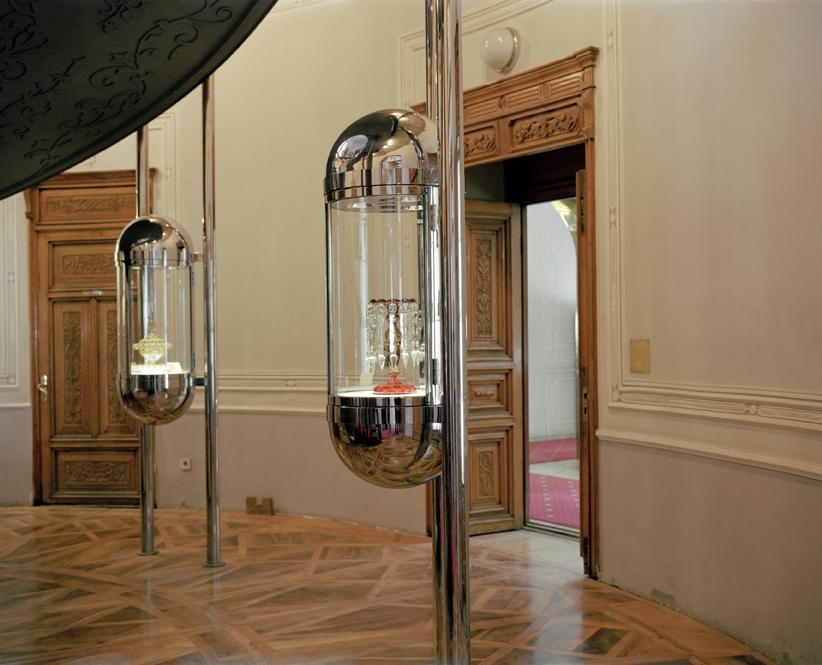The sensation is not the acclaimed collection of Tehran’s Museum of Contemporary Art with its Calder mobile and Judd ‘stack’ currently on display. Neither is it the remarkable Monir Farmanfarmaian’s permanent mirror work at the (virtually untouched since 1978) Niavaran Cultural Center. Nor is the sensation the many interesting young artists, curators and writers active in Iran’s capital today. The real sensation is something less expected: the late architect Hans Hollein’s 1978 project for the Glassware and Ceramic Museum of Iran. I learned about this well-kept secret after seeing Armin Linke’s photographs, which were included alongside those of Aglaia Konrad, in the recent Hollein retrospective (Hans Hollein: Everything Is Architecture) at Vienna’s Museum für Angewandte Kunst and was taken by their ‘out-of-time-ness’.
Inaugurated in a former Qajar palace in the centre of the city, the museum was founded to hold works dating from prehistory, through Achaemenid times and the Islamic period, and on to the twentieth century. Of necessity, a collection of glass and ceramics needs protection, so showcases became central to the presentation. In fact, the vitrines are the lead characters in this theatrical display: sculptural structures inhabiting all the spaces of the museum. As with other examples of inventive display techniques, such as Frederick Kiesler’s theatre exhibitions in Vienna and Paris during the 1920s, new practical and aesthetic solutions were pushed by the requirement that they should not touch the existing walls in the lavishly decorated interiors.
No less than 120 di.erent types of both classic- and science-fictional-looking showcases in highly polished stainless steel and chromeplated steel feature here. They have a pronounced presence in and of themselves, openly defying the assumption that display settings could, or should, be neutral, with technical fittings such as integrated and cleverly used lighting, air conditioning and humidity control. All of the cases look surprisingly postmodern for their time, and each is radically di.erent from the next. The language is recognisable from Hollein’s shop designs in Vienna, as well as from his well-known art museum in Mönchengladbach – the man evidently had a firm grasp of the rhetorics of display, commercial as well as museological.
With the Tehran museum, Hollein himself expressed the ambition both to allow for an educational approach and to highlight the status of the items on view as artworks – to facilitate emotional encounters with the objects. For example, glass is revealed as an example of early mass-production, and as something that can be an exquisite unique piece. A glass rosewater sprinkler from eleventh-century Gorgan and a mould-blown glass bottle from first- or secondcentury Azerbaijan stand out among the latter. But what was meant as a distinct and yet.integrated presentation is actually divided: in texts on Hollein’s contribution to the museum, mention of the items in the collection is absent, while in the material found at and transmitted by the museum, the architect has ‘disappeared’. It is as if there is an elephant in the crystal store.
Tehran’s Museum of Contemporary Art, the Niavaran Cultural Center and the Glassware and Ceramic Museum were all connected to Farah Diba, the wife of the last Shah. They testify to her cultural ambitions and now appear as time capsules. Rulers and regimes come and go, as do demonstrations and other countermovements, while these institutions remain the same. In this context, Hollein’s display comes across as out of time but not due to the same 1970s-aesthetic flavour that haunts the art museum and the cultural centre. Since its genesis, Hollein’s museum concept has played on the antique and futuristic at the same time, thus being genuinely temporally ambivalent. Or truly anachronistic, to speak with the language of theorist Mark Fisher. It is indeed the most intriguing collection display that I have ever seen.
This article was first published in the Jan & Feb 2015 issue.
